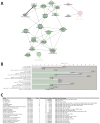The genetics of multiple sclerosis: an up-to-date review
- PMID: 22725956
- PMCID: PMC5967887
- DOI: 10.1111/j.1600-065X.2012.01134.x
The genetics of multiple sclerosis: an up-to-date review
Abstract
Multiple sclerosis (MS) is a prevalent inflammatory disease of the central nervous system that often leads to disability in young adults. Treatment options are limited and often only partly effective. The disease is likely caused by a complex interaction between multiple genes and environmental factors, leading to inflammatory-mediated central nervous system deterioration. A series of genomic studies have confirmed a central role for the immune system in the development of MS, including genetic association studies that have now dramatically expanded the roster of MS susceptibility genes beyond the longstanding human leukocyte antigen (HLA) association in MS first identified nearly 40 years ago. Advances in technology together with novel models for collaboration across research groups have enabled the discovery of more than 50 non-HLA genetic risk factors associated with MS. However, with a large proportion of the disease heritability still unaccounted for, current studies are now geared towards identification of causal alleles, associated pathways, epigenetic mechanisms, and gene-environment interactions. This article reviews recent efforts in addressing the genetics of MS and the challenges posed by an ever increasing amount of analyzable data, which is spearheading development of novel statistical methods necessary to cope with such complexity.
© 2012 John Wiley & Sons A/S.
Figures



References
-
- Hauser SL, Goodin DS. Multiple Sclerosis and other demyelinating diseases. In: Longo DI, editor. Harrison’s principles of internal medicine. 18. New York: McGraw-Hill; 2012. pp. 3395–409.
-
- Jersild C, Svejgaard A, Fog T. HL-A antigens and multiple sclerosis. Lancet. 1972;1:1240–1. - PubMed
-
- Naito S, Namerow N, Mickey MR, Terasaki PI. Multiple sclerosis: association with HL-A3. Tissue Antigens. 1972;2:1–4. - PubMed
-
- Olerup O, Hillert J. HLA class II-associated genetic susceptibility in multiple sclerosis: a critical evaluation. Tissue Antigens. 1991;38:1–15. - PubMed
-
- Barcellos LF, et al. Heterogeneity at the HLA-DRB1 locus and risk for multiple sclerosis. Hum Mol Genet. 2006;15:2813–24. - PubMed
Publication types
MeSH terms
Substances
Grants and funding
LinkOut - more resources
Full Text Sources
Other Literature Sources
Medical
Research Materials

